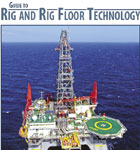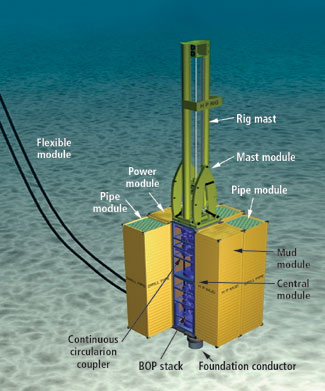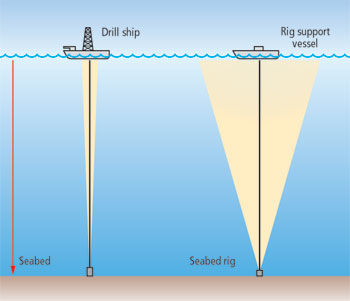Future rig designs: Seabed rig concept bolstered by cost analysis
December 2004 Supplement Future Rig Designs Seabed rig concept bolster
Seabed rig concept bolstered by cost analysisA radically new idea in drilling has been in the works for the past four years or so. Its inventor, Laurie Ayling of Maris International Ltd. conceived of this futuristic rig as well as the continuous circulation system shown in Application of a continuous circulation system. The basic concept is to install a fully automated rig atop a 42-in. Foundation Conductor on the seafloor. In extreme conditions of very thick unconsolidated sediment, the conductor diameter can be increased and, if necessary, a second conductor cemented inside the first. The principle is that the seabed rig is not supported by the seafloor but by the underlying formations. The rig is assembled in stages, with the assistance of a specialized ROV through the moonpool of a support vessel. It comprises up to 10 modules that contain (Fig. 1): the Central Module, which contains the well control equipment and drilling machinery – its (rotating) BOP stack locks onto the wellhead and is surmounted by a Continuous Circulation Coupler; the Rig Mast Module consists of the Top Drive carriage and the Stinger, which accesses and grips all tubulars from the inside with a probe, allowing for different internal diameters; the Mud Module; the Power Module; and the Tubular Handling System, which is a containerized “box” of tubulars that are accessible via the Stinger.
There are four key areas that drive the viability of the concept. First, because the rig is fully automated, it only requires a support vessel with ROV capability. This, in turn, means that generations of mobile drilling units (drillships, semis and the like) can be skipped, using only a suitable vessel of opportunity with a moonpool. Also, where dynamic positioning is required, such as in most deepwater, station-keeping requirements are greatly reduced, Fig. 2.
Second, because the rig resides on the seafloor, and there is no rigid riser, there is only an umbilical necessary for control and a flexible mud return line. This, in turn, allows a greatly expanded operational weather window, since the seafloor rig is immune to weather, and the lack of a rigid connection results in the much relaxed station-keeping requirement, allowing it to stay on station in all but the most severe conditions. The lack of a rigid connection also has positive safety implications. Next, one of the enablers of the seabed rig concept is the Continuous Circulation Coupler, the key enabling device of the Continuous Circulation System. This coupler is essential to eliminate the riser and to isolate the mud system from seawater. The ability to precisely manage and control drilling pressure, even in very narrow pressure windows, including ECD control, allows improved productivity (less skin), fewer kicks and lost circulation incidents, and extended casing points, which allows fewer casing strings. This also has positive safety implications. Drilling with single or dual gradient can be accomplished, depending on water depth, functional location of the mud pump and whether subsea processing of the drilling fluid is chosen. When all of the above is analyzed with respect to time and money, these become the final benefits. The inventor, as described in DeepStar document CTR 6901, did a comparative time and cost analysis. Two deepwater theoretical cases were compared with the seabed rig concept. The Cotton Tail “well,” in 5,000 ft of water, if drilled with the seabed rig, was found to be 10 days shorter and save 22% in costs compared to a conventionally drilled well. On the Coyote well, in 10,000 ft of water, the time and cost savings were found to be 16 days and save 34%, respectively. The seabed rig idea was developed as part of an ITF (Industry Technology Facilitator) Pioneer Project. It was supported by six offshore operators and received a UK DTI Smart award. The rig idea was presented at OTC 2003 and is described in detail in paper OTC15328. The status of this project is highly tentative. While discussions have taken place with various oil companies, and these continue, no one has yet chosen to fund this project to fruition. Given that rigs are quickly becoming fully automated, and the Continuous Circulation System is now commercial on land, this rig would seem the logical approach to drilling beyond today’s 10,000-ft limit, as well as reducing costs in conventional deep water. |
||||||||||||
- Coiled tubing drilling’s role in the energy transition (March 2024)
- Advancing offshore decarbonization through electrification of FPSOs (March 2024)
- Subsea technology- Corrosion monitoring: From failure to success (February 2024)
- Using data to create new completion efficiencies (February 2024)
- Digital tool kit enhances real-time decision-making to improve drilling efficiency and performance (February 2024)
- E&P outside the U.S. maintains a disciplined pace (February 2024)
- Applying ultra-deep LWD resistivity technology successfully in a SAGD operation (May 2019)
- Adoption of wireless intelligent completions advances (May 2019)
- Majors double down as takeaway crunch eases (April 2019)
- What’s new in well logging and formation evaluation (April 2019)
- Qualification of a 20,000-psi subsea BOP: A collaborative approach (February 2019)
- ConocoPhillips’ Greg Leveille sees rapid trajectory of technical advancement continuing (February 2019)





